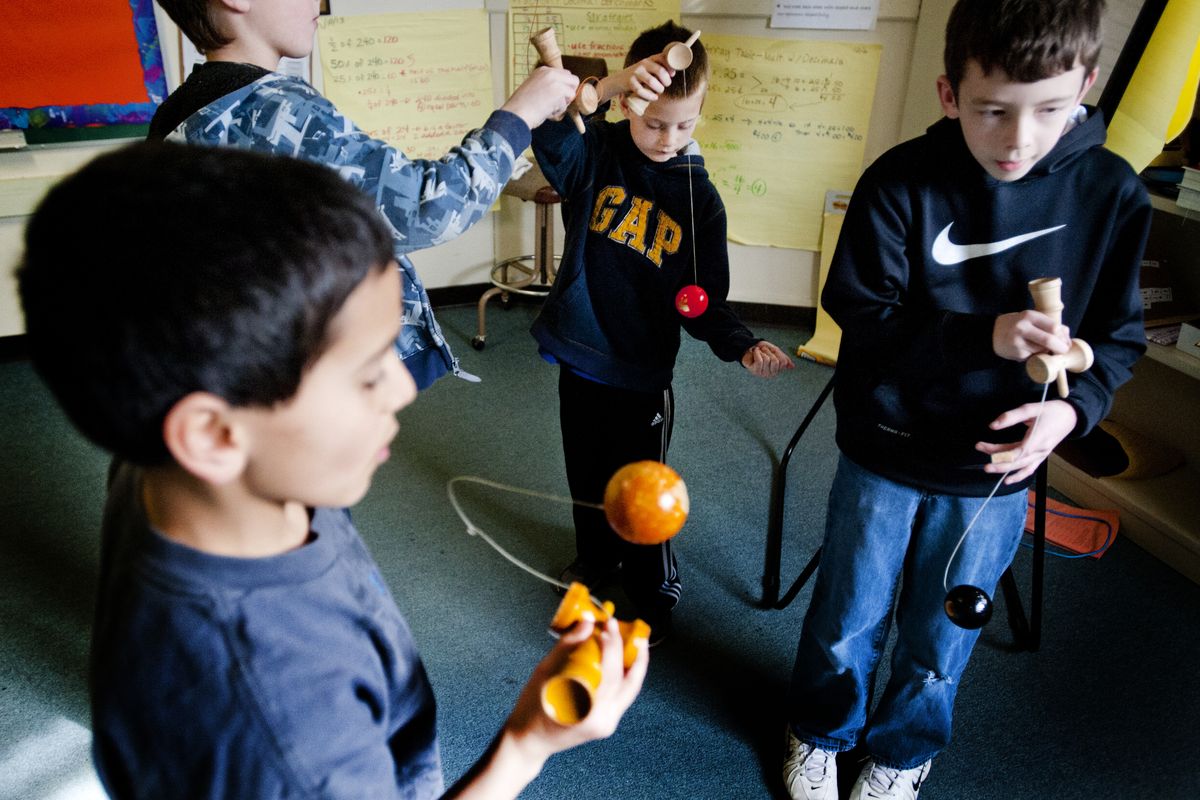Kendama contagious
Schools creating clubs for simple and wildly popular Japanese toy

Kendamas are the anti-video game: ball-and-cup toys that are quickly becoming this generation’s Hacky Sack, a craze spreading across the Inland Northwest and the United States, disrupting school days and sending hassled parents to the nearest toy store.
Clubs are forming, after-school programs have waiting lists, kendama parties are thrown and games are created; there are kendama professional teams, and YouTube videos featuring the toy are multiplying across the Internet.
“It’s really addicting,” said 12-year-old Max Boyer-Kendrick, a member of Finch Elementary School’s kendama club. “My parents tried it and they just couldn’t stop.”
Spokane’s Finch Elementary School has a special place on the playground for kids who want to play with kendamas, Principal Kim Harmon said. She’s seeing about 25 each day, and “it’s growing.”
The toy re-emerged in the U.S. when Jeremy Stephenson went to Japan and brought back a box of kendamas. He introduced them to his friends in the freestyle worlds of inline skating, skateboarding and skiing, and the toy took root as a freestyle activity. Stephenson then founded Kendama USA.
“It’s been something that’s been organically grown,” said San Francisco resident Jake Wiens, 29, a member of Kendama USA’s tribute team, which is one step below professional. “No one from the outside has been saying: We’ve got to push this and make it explode. It’s big because of human curiosity, not mass marketing.”
One of the games is called ken, and it’s similar to basketball’s horse or pig: Land a trick and the opponent has to do the same one. In another game, ken for ken, if the person can’t do the trick, they have to give up their kendama.
At Finch Elementary, there’s a rule against playing ken for ken.
So many kendamas are showing up in schools throughout the region that principals are creating rules specifically regarding the toy.
At Coeur d’Alene’s Canfield Middle School, the rules state: “Students may bring their Kendamas to school at their own risk. Students will be allowed to use them before school, during lunch and after school.” Kendamas brought to class or used between classes are confiscated to be picked up at the school office at the end of the day.
Several other schools in Spokane and Coeur d’Alene have established similar rules, and some others ask students to leave them at home.
At the same time, school officials are acknowledging the students’ fascination and making kendamas the focus of after-school enrichment programs and clubs. At Spokane’s Shadle Park High School there’s a waiting list for the next club.
Stores that carry kendamas have been amazed at the toy’s popularity.
“We can’t keep them in stock,” said Jackson Eubanks, a toy specialist at Coeur d’Alene’s Figpickels Toy Emporium. “We are sold out today. At least 15 people have called or came in about kendamas.”
He added, “We’ve doubled, tripled, quadrupled our orders; it doesn’t matter what we do, we sell them.”
Kerry Halls, a buyer for Boo Radley’s in downtown Spokane, said kendamas have been a blessing during the quieter sales months. The toy has been flying off the shelves since about November. Halls orders about 100 at time.
“Who knew that was going to be such a popular thing?” she said. “Kids are collecting them.”
Figpickels’ Eubanks said adults are buying kendamas too. The 21-year-old is a bit of an enthusiast himself.
“I have a few,” he said. “It’s something you have to master. It’s about not letting it get the best of you.”
Figpickels recently hosted a kendama pro who performed tricks for patrons. Hunter Bailey, a Coeur d’Alene High School junior, is one of about 20 pros nationwide. He’s sponsored by Kendama Co.
“It’s crazy, it’s really big in Europe and Canada too, places you wouldn’t think of,” Bailey said.
The teen went pro after Kendama Co. spotted him in a couple of kendama edits – as the YouTube videos are called – and contacted him, he said. Bailey is not paid, but his travel expenses are covered to compete with teams around the world.
His connection with the toy came by chance. One day during a break from skiing, he started playing with a friend’s kendama.
“I’ve been hooked ever since,” he said. “It was an interesting toy, and I didn’t want it to beat me.”
Bailey added, “It takes place of a video game because it uses your mind and creativity. Like I said, you don’t want it to get the best of you. I think it will never end and continue always.”